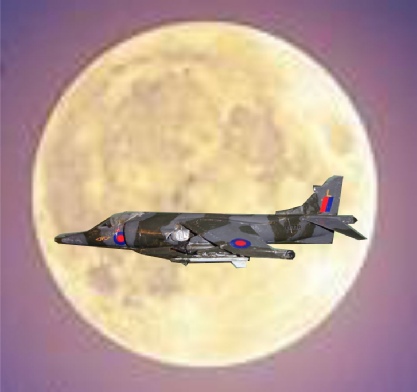I wrote this for a Creative Writing workshop
SCRAMBLE! SCRAMBLE! SCRAMBLE!
31st October 1971
Halloween is a night for games – but the RAF doesn’t play games with multi-
As I taxied out to the end of runway 26, I could see the traffic passing a few hundred yards away on the nearby A1. I knew most drivers would glance across at me – I’d done exactly the same many times before. Now I was the one sitting in the cockpit of a Harrier – the unique jump jet that even the Americans had bought!
I didn't need to use the mile-
Tonight was, however, far from normal.
Tonight, a Harrier had been placed on QRA. – Quick Reaction Alert; a role that was usually handled by Mach 2 Lightning interceptors. They were scrambled on a routine basis to investigate potential intruders into UK airspace – often Russian aircraft on maritime reconnaissance or flights over to Cuba; or just testing our air defences.
I could certainly match the Russians’ speed – but it would take me an hour to intercept them against a matter of minutes for the supersonic Lightning. Whilst Harriers were capable of fighting other aircraft as would be proved about ten years later in the Falklands, our role was primarily ground attack. So, what was going on?
Just as I got to the end of the runway my radio burst into life “Firebird zero-
I completed my pre-
Free of the ground, feeling at one with my aircraft, doing what I’d been trained for; following in the footsteps of those heroes from my childhood – defending the country. This is what I’d dreamed of while growing up. That training had taught me to be calm and professional but at moments like this, I couldn't help feeling a mixture of apprehension and excitement.
Overhead, the full moon was bright with just the occasional cloud drifting across its face. It was amazing to think that it was only 2 years since Neil Armstrong made his ‘giant leap for mankind’ onto its surface.
I was soon at 10,000 feet as instructed.
“Neatishead, this is Firebird zero-
“Firebird zero-
If the target was only flying at 75 knots and only at 10,000 feet – that explained why they’ve sent up a Harrier to check it out instead of a Lightning – which would fall out of the sky if it tried to slow down sufficiently to get a good visual identification. The Harrier could use its vectored thrust, pointing the engine output downwards, to let it operate at any speed – including slowly backwards.
I did some mental arithmetic, eighty miles at a closing speed of around ten miles per minute – so less than eight minutes. Assuming that the target maintained its current speed and direction. It might land somewhere in the East Midlands – it might even be a cargo flight which has lost communications; well probably not at just 75 knots. A helicopter perhaps? A microlight? Either could then touch down in a very small space – but so could I!
I could now see the lights of East Midlands airport ahead just as control called instructing me to turn north and make contact with the next controller. I pushed the stick over to the right and banked away from the airport. We certainly didn’t want to scare holidaymakers returning from Marbella – or even an overnight parcel flight. I switched radio channels and called Northern Control.
“Patrington, this is Firebird zero-
Control acknowledged my call and instructed me to remain on my present course and speed. A few minutes later, as the airport lights slipped away behind us, they brought me back onto my original flight path.
Over the Peak District, the bright areas that marked the towns and cities of the East Midlands and South Yorkshire disappeared astern; replaced with just the occasional twinkle from villages – or vehicle headlights winding their way over the hills. The bright moon reflected off the top of the occasional clouds or the surface of lakes below me. Back on the ground, kids would have been going from house to house “trick or treating”.
“Firebird zero-
At my closing speed, I would have been with the target in less than a minute. So, I should have been able to see it on my radar very soon.
Control called again to advise that the target was increasing speed rapidly. It was already at 200 knots; much faster than a helicopter or microlight could fly – so what was it? What was I chasing?
Control asked if I had visual on the target.
“Firebird zero-
I increased my speed to allow me to close on the target. Still nothing visible in the darkness. The lights of Oldham and Manchester lay away to port. Once more the ground below us was dark apart from the occasional lights of villages and cars on the roads. At least if I needed to force the intruder down; even, if necessary, shooting at it, there was little danger of damage on the ground. Hopefully, it wouldn’t come to that. I should have been able to stay with the target whatever manoeuvres it came up with.
I still couldn't see the target despite the radar showing that I was virtually on top of it; so, as we passed over Burnley, I decided to drop down and try to get the intruder silhouetted against the brightness of the moon.
Then, I caught a glimpse of something – but it, too, was losing height – heading for the desolate rocky ground below us. It slowed and seemed to be making for a glow that developed into a fire. I switched on my landing lights and caught the target just as it landed on Pendle Hill and I realised there was a group of black cloaked individuals standing around the bonfire.
“And that’s the story of when I chased after a witch on her broomstick," I told Sarah and Michael my 8 and 9-
“Dad – you’ll scare them silly with your stories! Right,” said Jo, my daughter, to the children, “get your coats on and Grandad will take you out ‘Trick or Treating’ “.



